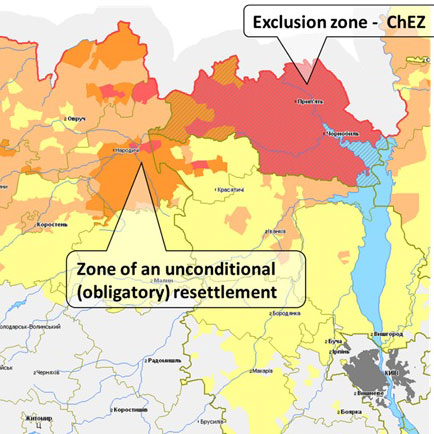Objective
Thirty years after the Chornobyl accident, more than 4000 square kilometres of land – an area larger than Hampshire – remains officially abandoned in the Ukraine. The President of Ukraine has recently tasked the Ukrainian State Agency for Exclusion Zone Management (SAUEZM) and the Chornobyl ECOCENTRE to create a new plan for this huge area. The purpose of the NERC-funded iCLEAR project (a NERC follow-on project from RATE TREE) was to support these agencies in developing a new strategy for the Chornobyl Exclusion Zone (CEZ) and Zone of Obligatory Resettlement (ZoR) (See Map).

Stakeholder consultation
Incorporation of the views of key stakeholders is key to the new management strategy. A series of structured Stakeholder Group meetings were held to gather views from a wide range of participants including: The Pivnichna Pushcha Forestry Enterprise, Departments of State Administration of the Kiev Region and Ivankiv and Zhytomyr Districts; Chornobyl and Drevlyansky Biosphere Reserves; WWF Ukraine; Chornobyl Tourism Association.
Collection of key information for management
Key mapping and monitoring data was collected in an Environmental Management Information System to assist decision makers and for public communication:
- Historic surface contamination (137Cs; 90Sr; 241Am; Pu isotopes) and dose maps;
- Current situation and projections for future decades;
- Surface and groundwater distribution and drainage for wetland management;
- Evaluation of radiation risk from forest fires for firefighters and the public;
- Wildlife composition and distribution to support wildlife tourism.
Protocol for potential re-zoning
In order to re-zone areas currently abandoned (but potentially now suitable for re-use) area there needs to be a change in the legislative basis for zone designation. The iCLEAR project will support this legislative change by developing the first official protocol of actions necessary to determine land which is safe for agricultural activity and re-habitation. This will include methods for evaluation of contamination density, external dose assessment and models for transfer of radioactivity to key foodstuffs, in particular milk and milk products.
Impact
The Chornobyl accident affected millions of people in Ukraine and changed public perceptions of nuclear power Worldwide. The iCLEAR project will help move forward the slow process of long term recovery from the accident. There are huge potential economic benefits of re-use of currently abandoned lands, as well as ecosystem benefits of careful management of what represents one of the largest wilderness areas in Europe. Further, active public communication carried out in the project will support affected populations by presenting clear information on radiation risk.